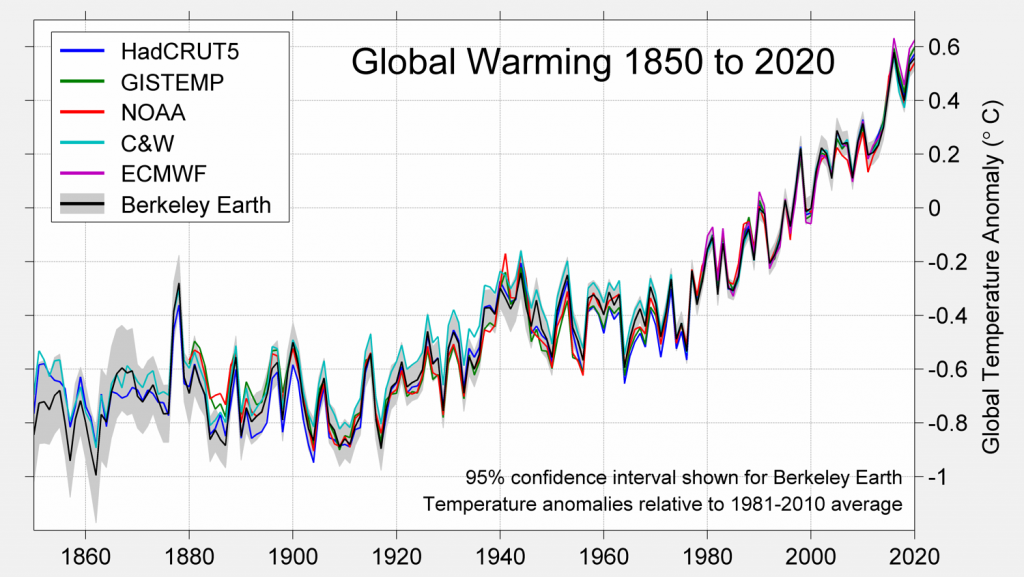
January 22, 2021 Friday

Comparison of global warming trend from six different datasets. Photo from Berkeley Earth.
MANILA, 23 January 2021 — Only greater and ambitious climate commitments from nations across the globe could halt the increasing trend of greenhouse gas emissions as 2020 was officially dubbed as one of the three warmest years on record, according to the consolidated datasets from various international climate monitoring centers.
Despite the reduced economic activity across the globe due to the Covid-19 pandemic, and the prevalence of the La Niña phenomenon expected to last until April of this year, climate change continues to accelerate with remarkable speed. The warmest six years have all been since 2015, with 2016, 2019 and 2020 as the top three, according to the World Meteorological Organization (WMO).
The WMO uses different datasets that combine meteorological and marine observations to produce a complete analysis of the atmosphere. All of these projections show that the average global temperature has continued to accelerate this past year.
Scientists from the Copernicus Climate Change Service (C3S) also revealed that globally, 2020 was tied with the previous warmest year 2016. Carbon dioxide concentrations in the atmosphere continue to rise at a rate of approximately 2.3 particles per million (ppm) a year in 2020, reaching a maximum of 413 ppm during May 2020.
The Japanese Meteorological Agency (JMA) preliminary analysis also ranked 2020 as the warmest year. The annual anomaly of the global average surface temperature in 2020, including the average of the near-surface air temperature over land and sea surface temperature, was +0.47°C above the 1981-2010 average or +0.83°C above the 20th century average. On a longer time scale, global average surface temperatures have risen at a rate of about 0.75°C per century.
Meanwhile, the National Oceanic and Atmospheric Administration (NOAA) Merged Land Ocean Global Surface Temperature Analysis (NOAAGlobalTemp) names 2020 as the second-hottest year on record for the planet, as the average land and ocean surface temperature across the globe in 2020 was 0.98 of a degree Celsius above average — just 0.02 of a degree Celsius cooler than the 2016 record. Unlike NASA, NOAA uses a different baseline period (1901-2000) and methodology.
The Met Office HadCRUT5 global temperature series shows that the average for 2020 as a whole was 1.28±0.08°C above pre-industrial levels, taken as the average over the period 1850-1900. This also concludes 2020 nominally the second warmest year in the dataset’s record.
Lastly, the Berkeley Earth also concluded that 2020 was the second warmest year on Earth since 1850. The estimate of the global mean temperature in 2020 was slightly colder than 2016, but warmer than every other year that has been directly measured. The difference between 2020 and 2016 was also by 0.022 °C.
The slight disagreement in the ranking reflects both the uncertainty in these estimations and the differences in how various research programs look at the Earth. Each uses a somewhat different selection of source data and different methods of interpolation and correcting for measurement errors. The small differences among these datasets are all within the margin of error for calculating the average global temperature, according to WMO.
The temperature figures will be incorporated into the final WMO report on the State of the Climate in 2020 that will be issued in March 2021. It will also include information on all leading climate indicators and selected climate impacts, and updates on the provisional report issued in December 2020.
The Paris Agreement seeks to hold the increase in the global average temperature to well below 2°C above pre-industrial levels while pursuing efforts to limit the temperature increase to 1.5°C above pre-industrial levels. At 1.2 °C above the pre-industrial levels, the global average temperature in 2020 is already approaching the lower limit of temperature increase the Paris Agreement seeks to avert. There is at least a one in five chance of the average global temperature temporarily exceeding 1.5 °C by 2024, according to WMO.
The Met Office annual global temperature forecast for 2021 suggests that this year will once again enter the series of the Earth’s hottest years, despite being influenced by the temporary cooling of La Niña, the effects of which are typically strongest in the second year of the event.
Given these projections, the CCC warned that the Philippines would be severely impacted given our status as a developing and vulnerable country. These projections might mean more frequent and intense extreme weather disturbances like tropical cyclones which will impact our poorest communities.
It can be remembered that in the last quarter of last year, the Philippines recorded almost ₱15 billion worth of damages in the agriculture sector due to three successive typhoons - Typhoons Quinta, Super Typhoon Rolly, and Typhoon Ulysses – which hit the island of Luzon in a span of a couple of weeks, affecting hundreds of thousands of farmers and fisherfolks.
On infrastructure, almost ₱13 billion worth of damages were recorded by the National Disaster Risk Reduction and Management Council for Typhoon Ulysses alone.
The impacts of climate change are felt across all sectors globally. The CCC emphasized the need to strengthen public-private partnerships in promoting climate-resilient investments, and in mainstreaming disaster risk reduction, climate change adaptation and mitigation.